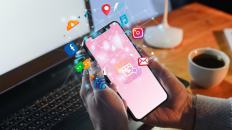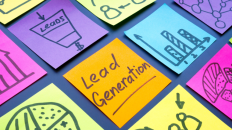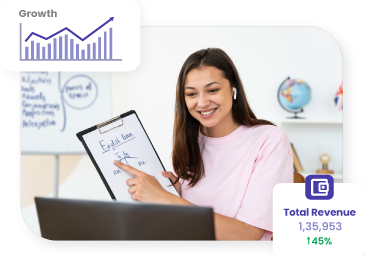In 2025, mastering high-ticket sales isn’t just for big brands; it’s for creators like you. Whether you’re a coach selling an INR 50,000 program, a designer offering one-on-one mentorship, or a podcaster launching an exclusive membership, high-ticket pricing helps you earn more without burning out.
But selling premium offers isn’t about pressure tactics. It’s about positioning, trust, and showing your audience the real value of your work. As a creator juggling content, marketing, and delivery on your own, you need a sales strategy that’s smart, simple, and doable, without needing a massive team or fancy tools.
In this post, we’ll walk you through creator-friendly strategies to close high-ticket sales confidently, connect with the right buyers, and turn your expertise into a sustainable income, one high-value client at a time.
What are High-Ticket Sales?
High-ticket sales involve selling digital products or services priced at a premium, typically INR 50,000 and above. These offers are seen as investments by your audience, which means trust, expertise, and strong positioning are essential.
For example, if you’re a mindset coach offering an INR 1,00,000 12-week transformation program, or a graphic designer selling an INR 75,000 design mentorship, you’re operating in the high-ticket space. Unlike low-ticket items like an INR 499 eBook or INR 999 workshop, high-ticket sales require deeper conversations, personalised pitches, and a strong connection with your potential buyer.
Now that you know what qualifies as a high-ticket offer, let’s explore why learning to close these sales can elevate your creator journey in 2025.
Why High-Ticket Sales Are Worth the Effort
Let’s be real: Closing high-ticket offers takes effort. You’ll need to engage in deeper conversations, handle queries personally, and clearly show your value through your content, DMs, or even discovery calls.
But here’s the truth: the payoff is more than worth it. Here’s why:
1. Fewer Customers, Bigger Profits
With high-ticket offers, you can achieve serious revenue with a fraction of the customer base you’d need for low-ticket products.
For example:
Sell an INR 799 eBook? You’ll need 1,000 customers to earn INR 7,99,000.
Sell an INR 79,999 coaching program? You only need 10.
2. Better Client Commitment = Better Results
When someone invests INR 2,00,000, they’re in. High-ticket buyers show up, take action, and follow through because they have real skin in the game.
This means:
- Higher completion rates: They actually finish your program.
- Better testimonials: Results speak louder when people commit fully.
- Real transformations: You get to make a meaningful impact.
Freebie seekers rarely do the work. High-ticket clients do because they value what they pay for.
3. Stronger Relationships and Loyalty

High-ticket sales naturally build deeper customer relationships. You’re not just selling a product, you’re selling access, transformation, and often yourself.
The result?
- Higher trust: Your audience sees you as a guide, not just a creator.
- Stronger word-of-mouth: Happy clients rave about you in their circles.
- True fans: You’re not just making a sale but building a community that sticks with you for years.
High-ticket isn’t just about money. It’s about creating real impact and loyal supporters who grow with your brand.
4. More Sustainable, Scalable Business Model
Low-ticket businesses often depend on massive traffic, ad spend, or low-margin volume. It’s a grind.
High-ticket? You can scale through:
- Targeted marketing: Reach fewer, better-qualified leads with personalized messaging that resonates deeply and drives meaningful conversions.
- High-impact communities: Leverage loyal audiences or mastermind-style groups that generate referrals, support, and recurring high-ticket sales.
- Fewer, deeper relationships: Build long-term trust with fewer clients, offering more value and reducing churn and customer acquisition stress.
This creates a business that’s leaner, more profitable, and less stressful to run. Now that you know why high-ticket sales are worth the effort, let’s break down exactly how to master them in 2025, with 7 proven tips that turn interest into income.
Also Read: How To Use Webinars To Upsell Your High-Ticket Courses?
7 Tips to Master High-Ticket Sales in 2025
Mastering high-ticket sales in 2025 requires a strategic approach that aligns with evolving buyer expectations and market dynamics.
70% of clients cite accountability as the main reason for hiring a coach. That means your high-ticket offer doesn’t just need to look good, it needs to deliver results and build trust.
Here’s an in-depth guide to help you excel in this domain:
1. Understand Your Ideal Audience Deeply
High-ticket buyers prioritize value and transformation. They’re investing in outcomes, not features. That means you must go beyond surface-level demographics and truly understand what keeps them up at night.
Whether you’re a wellness coach helping clients overcome burnout or a design mentor guiding beginners to launch their freelance career, your ideal buyer is someone with a clear pain point and a willingness to pay for real change.
Example:
If you’re a productivity coach, your ideal high-ticket client might be:
- A mid-level professional in their 30s who struggles with focus and burnout.
- They’ve tried free YouTube videos and INR 999 productivity courses but they need accountability and structure to truly change.
- They’re willing to pay INR 50,000+ for a 1:1 coaching plan with weekly check-ins, templates, and personal feedback.
They’re not looking for “more content.” They want clarity, confidence, and a system that works.
Action Steps:
- Create a Deep Client Profile: Don’t just list age and income. Identify pain points, fears, goals, and obstacles. Use interviews, polls, or DMs to gather real insights from your audience.
- Use Active Listening in Discovery Calls: When you speak to potential clients, go beyond “What do you want?” Ask, “Why now?” or “What happens if nothing changes?” These reveal urgency.
- Customise Your Messaging: Don’t say, “This course will teach you X.” Say, “This course helps you finally break through Y so you can achieve Z.”
2. Position Yourself as a Trusted Advisor

Your audience isn’t looking for a slick sales pitch; they’re looking for guidance. In 2025, when buyers are bombarded with online offers, the creators who stand out aren’t the loudest. They’re the most helpful.
Being seen as a trusted advisor means showing up with solutions, not just selling features. When someone sees you as the person who “gets it,” they’re far more likely to invest, especially in a high-ticket offer.
Example:
Suppose you’re a fitness coach selling an INR 60,000 transformation program. Instead of just promoting the price and features, share your personal journey, explain the science behind your methods, or walk through a past client’s progress from burnout to balance.
When you do this consistently, your audience starts thinking, “This person knows exactly what I need.” This shifts your role from a “seller” to a “solution provider.”
Action Steps:
- Share Real Stories: Use case studies, before-after results, or transformation videos from past clients. If you’re just starting out, document your own journey or offer a few beta slots in exchange for testimonials.
- Give Value Before You Ask: Offer a free mini course, an Instagram carousel breaking down a key concept, or a 15-minute discovery call. This builds trust and reduces risk for the buyer.
- Be Honest and Clear: Don’t oversell. Instead of “This will change your life,” say “This is for people who are ready to commit and want a proven path to XYZ.” Authenticity sells more than hype, especially at high-ticket prices.
3. Learn the Art of Discovery Calls
Discovery calls are more than sales conversations. They’re trust-building moments. In high-ticket sales, your ability to truly understand your prospect’s pain points, goals, and hesitations sets the foundation for conversion.
You’re not just listening to what they say. They’re often telling you what they really need underneath the surface. And your job is to help them see what’s possible with your guidance.
Example:
If you’re a business coach offering an INR 1,00,000 growth program, a discovery call isn’t just about listing benefits. It’s about making them understand why they feel stuck, what strategies they’ve tried, and what success would look like if things changed.
Action Steps:
- Ask powerful, open-ended questions like “What’s the real cost of staying where you are?” or “Why is now the right time to get help?”
- Reflect their goals and challenges back to them so they feel heard and understood.
- Don’t rush to pitch. Guide the conversation toward clarity and trust. The more they talk, the more you learn.
4. Build a Premium Offer that Solves Real Problems
High-ticket buyers don’t just want more content. They want real transformation. Your offer needs to feel like the bridge between where they are and where they want to be.
Whether you’re creating your own offer or selling someone else’s, clarity and depth are non-negotiable.
Example:
If you’re a mindset coach, “8 video modules and 2 bonus PDFs” won’t justify a INR 75,000 price tag. But “a 90-day mindset reset with personalized coaching, weekly mindset audits, and access to a private client group” paints a picture of value and transformation.
Action Steps:
- Start with the outcome. What real change are you helping people achieve? Build backward from there.
- Package your offer clearly. Explain the journey, not just the features. Think: “Week-by-week milestones” instead of “8 modules.”
- Articulate Return On Investment (ROI). Can this save time, grow income, or improve quality of life? Spell it out.
5. Handle Objections with Empathy, Not Pressure
When someone says, “It’s too expensive” or “I need to think about it,” they’re often really saying, “I’m not sure this will work for me.” Responding with understanding, not urgency, makes all the difference.
Example:
For example: A freelancer hesitating to join your high-ticket mentorship because they’ve been burned by courses in the past. Instead of pushing them to decide, share how your offer is different and relate to their hesitation.
Action Steps:
- Validate their concerns. Say, “That makes sense. A lot of people I’ve worked with felt the same way at first.”
- Share relevant proof. Point to a similar client who had that fear but got results.
- Ask guiding questions. “What would need to happen for this to feel like the right investment for you?”
6. Use Social Proof That Shows Real Transformation
People trust people. No amount of copywriting can replace the impact of a real story. Social proof isn’t just about testimonials; it’s about building belief.
Example:
If you helped a client triple their income in 3 months, don’t just say “Client saw results.” Share the journey: what they struggled with, how they implemented your system, and where they are now.
Action Steps:
- Collect detailed testimonials, not just “It was great,” but “Before working with X, I was stuck doing Y. Now, I’ve achieved Z.”
- Create mini case studies for social media or your landing page. Focus on pain, process, and payoff.
- Encourage user-generated content. A selfie video from a happy client can build more trust than a polished ad.
7. Follow Up Like a Trusted Guide, Not a Salesperson

Most high-ticket sales don’t close on the first call. That doesn’t mean the prospect’s a no. It just means they need time, support, and reassurance. Great follow-up builds trust, not pressure.
Example:
After a discovery call, instead of a generic “Just checking in” message, send a voice note summarizing what they told you, why the offer fits, and what the next step they could take, even if it’s not with you right now.
Action Steps:
- Follow up within 24–48 hours with a personalized recap of your conversation and a clear next step.
- Share helpful resources related to their goals. This keeps the relationship alive and shows genuine care.
- Set reminders to check in weekly (without being pushy). Sometimes, it’s the third or fourth message that lands.
Creating high-ticket products is one thing, turning them into consistent sales is where the real challenge lies. Exly empowers creators to move from just presenting to actually converting by offering a complete set of tools designed to convert.
- Zoom Integration: Host live webinars directly through Exly with automatic Zoom link generation, making setup fast and hassle-free.
- Smart Scheduling & Booking: Manage your products/services effortlessly with Exly’s intuitive scheduler, which enables clients to book with just a few clicks.
- Seamless Payment Collection: Accept payments smoothly through multiple methods including UPI, debit/credit cards, net banking, and digital wallets.
With Exly’s all-in-one platform, you can transform your products into high-converting sales engines, simplify your workflows, and focus on what matters most: delivering exceptional content.
Also Read: How to Build a High-Converting Landing Page for an Online Course
Now that you know the strategies, it’s time to shift focus to your buyers. Because selling isn’t just about pitching; it’s about understanding how your audience thinks, feels, and makes decisions.
The Psychology Behind High-Ticket Sales
Selling high-ticket offers goes far deeper than listing benefits or justifying the price. At premium levels, buyers are driven by emotion, self-image, trust, and the transformation your offer represents.
In 2025, understanding what truly influences these buying decisions is your unfair advantage. Let’s break down the core psychological triggers behind high-ticket sales and how to craft offers that speak directly to them.
1. Identity and Status
High-ticket buyers often make decisions that align with how they see themselves or who they want to become.
- Buying an INR 10,000 mastermind isn’t just about networking; it’s about being seen as someone who belongs in that circle.
- Investing in a premium coaching program says, “I take my growth seriously.”
- Choosing a top-tier business service communicates success and professionalism to others.
Position your offer as something that top performers, leaders, or serious players use to win, so your buyer feels empowered and elevated by joining.
2. Perceived Value and Transformation
People don’t pay INR 5,000 for information. They pay for transformation.
High-ticket buyers want real, measurable change, whether it’s income growth, weight loss, visibility, confidence, or clarity. A compelling value proposition can increase sales by up to 20% and boost customer satisfaction by 15%.
Shift your messaging from “what’s included” to “what will change.” Highlight results, success stories, and specific before-and-after scenarios.
3. Urgency Through Timing, Not Pressure
Old-school urgency tricks (countdowns, fake scarcity) are losing effectiveness in 2025. Buyers are savvier and they want real reasons to act.
Today’s urgency comes from timing and personal readiness.
- “Now is the perfect time to launch your brand.”
- “If you wait, you’ll stay stuck for another quarter.”
- “You’re losing revenue every day you delay.”
Modern urgency = internal motivation + timing relevance.
Tap into where your prospect is in their journey. Use messaging like “If you’re feeling stuck at X, this is your moment to move to Y.”
4. The Power of Exclusivity
High-ticket buyers crave access, not mass-market solutions. They want what others can’t have.
Whether it’s limited seats, private coaching, or invite-only communities, exclusivity signals value and creates desire.
Use scarcity authentically. Limit access, vet applicants, or gate your community so that buying your offer feels like getting in.
5. Trust and Risk Reduction
The higher the price, the higher the risk, so trust becomes everything.
Buyers want to know:
- “Will this work for me?”
- “Do I trust this person to deliver?”
- “What happens if it doesn’t work?”
Offer guarantees or refund options (if it fits your model). Showcase deep testimonials and social proof. Be transparent about who your offer is not for; it builds credibility.
Once you grasp the emotional and psychological triggers driving high-ticket buyers, you’re well-positioned to generate consistent wins, but how much can you realistically expect to earn when you get it right? Let’s find out in the next section.
How Much Can You Make with High-Ticket Sales?
The earning potential in high-ticket sales is massive and often only limited by your offer, your strategy, and your ability to close. Since each sale brings in thousands, or even tens of thousands, of rupees, even a small number of deals per month can lead to six- or seven-figure annual income.
Here’s a quick breakdown to give you an idea:
- INR 5,000 offer x 4 clients/month = INR 20,000/month = INR 240,000/year
- INR 10,000 offer x 6 clients/month = INR 60,000/month = INR 720,000/year
- INR 25,000 offer x 3 clients/month = INR 75,000/month = INR 900,000/year
Of course, results vary based on your industry, experience, marketing, and network. But the key point is this: you don’t need hundreds of customers to make serious money. Instead, with a well-positioned offer and the right sales system, just a few high-quality clients each month can change your income and your lifestyle dramatically.
Many high-ticket closers, coaches, consultants, and SaaS sales professionals now earn multiple six figures, while top performers in the space easily cross the seven-figure mark.
These numbers paint a clear picture of what’s possible, but success in high-ticket sales also hinges on choosing the right marketing model to match your goals and audience.
What Marketing Models to Choose for High-Ticket Sales

Selling high-ticket products isn’t about throwing up a flashy sales page and hoping for the best. It’s about building trust, creating a premium experience, and positioning your offer to the right people in the right way.
Here are the top marketing models that are actually working for high-ticket sales:
1. Community-Led Growth (a.k.a. the Community Flywheel)
Best for: Coaches, course creators, tech, and membership platforms
Instead of cold ads and funnels, under this model, you build a community first, create a sense of belonging, then offer high-value products that solve real problems for your members.
Flywheel Effect: Community builds trust → trust increases conversions → new buyers feed the community.
2. Hybrid Webinar Funnels
Best for: Thought leaders, consultants, SaaS, B2B
Hybrid webinar funnels are a modern evolution of traditional webinars. They are designed to engage, educate, and convert without overwhelming your audience or relying on outdated pitch-heavy formats. Unlike the old-school 2-hour “pitch-fests,” hybrid webinars combine the efficiency of automation with just enough personal touch to build real connection and trust.
These funnels typically blend:
- On-demand training that viewers can access anytime, increasing convenience and reach
- Personal connection points such as live Q&A sessions, strategy calls, or direct follow-up calls
- Automated email nurture sequences
If you’re a creator or coach looking to implement a hybrid webinar funnel without juggling multiple tools, Exly makes it simple. From hosting on-demand sessions and collecting sign-ups to automating follow-ups and booking strategy calls, Exly gives you everything you need in one platform.
3. High-Touch, Application-Based Sales
Best for: Premium services, masterminds, agencies
This model focuses on exclusivity. Customers apply to work with you, and you accept only those who are the right fit.
Why it works:
- Builds authority and demand
- Attracts serious buyers only
- Positions your offer as elite and selective
Process Example:
- Short form → Qualification call → Offer invitation
- Often used with Calendly + CRM like Close or HubSpot
4. Content-Driven Authority Funnels
Best for: Creators, educators, consultants
Build a brand that sells while you sleep through long-form content. Be it podcasts, blogs, newsletters, or YouTube, paired with targeted CTAs and a soft funnel.
Why it works for high-ticket:
- Establishes thought leadership
- Warms up leads over time
- Pulls in highly qualified prospects
5. Affiliate and Influencer Partnerships
Best for: Scalable service-based businesses and coaching programs
One powerful way to expand your reach without doing all the heavy lifting yourself is by partnering with influencers, affiliates, or loyal users who genuinely believe in your offer. By offering generous commissions (typically 15–40%), you enable others to promote your services to their own warm, trusting audiences.
Why it works:
- Builds trust through someone else’s audience
- Scales quickly without high ad spend
- Drives warm, qualified traffic
Each of these marketing models plays a vital role in attracting the right kind of clients but understanding the key differences between high-ticket and low-ticket customers is what ensures you actually keep and convert them.
Also Read: 7 Effective Book Marketing Strategies For Higher Sales
High-Ticket vs. Low-Ticket Customers: What’s the Difference?
The gap between high-ticket and low-ticket customers isn’t just about how much they spend. It’s about mindset, behavior, and expectations. Understanding the difference will help you tailor your sales, delivery, and marketing strategies to attract the right people.
Here’s how they compare:
| Category | Low-ticket Customers | High-ticket Customers |
| Price Sensitivity | Highly price-conscious; often bargain hunters | Value-focused; willing to invest for real results |
| Decision-making | Fast but impulsive | Slower, more deliberate, but more committed |
| Support Needs | Frequently ask for hand-holding or refunds | Expect premium support, but ask fewer questions |
| Loyalty | Easily swayed by cheaper alternatives | More loyal if value is delivered |
| Motivation | Looking for a quick win or small convenience | Seeking transformation, ROI, or major outcomes |
| Lifetime Value (LTV) | Low; may not return | High; may return, refer others, or buy again |
| Engagement | Lower; may ghost after purchase | Higher; often participate in communities or events |
| Churn Rate | High | Low if expectations are exceeded |
Now that you know who you’re talking to and how they behave, let’s answer a question many aspiring sellers ask: can you really make high-ticket sales work as a side hustle?
Can High-Ticket Sales Be a Side Hustle?
Absolutely, with the right strategy. High-ticket sales can 100% be a side hustle and a highly profitable one at that.
Unlike traditional side gigs that often require grinding for hours to earn a few extra bucks, high-ticket sales allow you to work smarter, not harder, by closing just a few deals a month for four- or five-figure commissions.
A standout example is Danielle Leslie, who built a high-ticket course called #CourseFromScratch, priced at $2,497 (INR 2,13,061). Not only has she sold it successfully, but she’s also helped thousands of others launch and grow their own profitable online courses.
Here’s why it works as a side hustle:
- Fewer Sales, Bigger Paydays: You don’t need to close 50 deals a month. Just 1–3 high-ticket sales can bring in thousands in extra income.
- Flexible Schedule: Many high-ticket sales roles, especially remote closing or affiliate-style models, let you work evenings, weekends, or whenever you have time.
- No Product Creation Needed: You can sell someone else’s premium offer (like coaching programs, masterminds, or SaaS platforms) and still earn big commissions, sometimes up to 20–50%.
- Low Upfront Cost: If you’re doing remote high-ticket sales, all you usually need is a laptop, a Wi-Fi connection, and some training or mentorship.
For example, let’s say you’re working full-time but start closing one INR 10,000 coaching program per month on the side with a 20% commission. That’s INR 2,000/month, an extra INR 24,000/year, from just a few calls a week.
So yes, high-ticket sales can be a side hustle, but they have serious potential to scale into a full-time income stream if you want to go all in.
Conclusion
Mastering high-ticket sales in 2025 is about serving with depth, clarity, and trust. Today’s buyers aren’t just looking for content; they’re investing in creators who offer real transformation, personalised experiences, and consistent results.
Whether you’re selling an INR 50,000 coaching program, a premium course, or 1:1 mentorship, your success depends on how well you understand your audience, build authority, and create a seamless, high-trust journey from discovery to conversion.
And if you’re ready to make that journey easier, Exly is here to help. With custom-branded websites, automated customer management, and seamless tools to sell premium digital products, Exly empowers solo creators to scale without burnout.
From collecting payments to running live workshops and managing leads, everything you need to build, launch, and grow your high-ticket offers is in one place. Get started for free with Exly and turn your premium offer into a powerful, profitable business.





